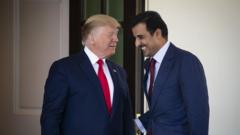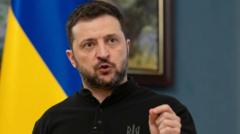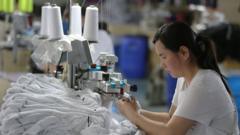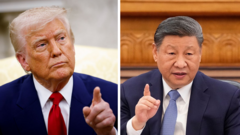As Donald Trump embarks on his official visit to Saudi Arabia and the Gulf, the focus remains on attracting significant investment to support his economic agenda, amid ongoing trade disruptions.
**Trump Seeks Investment Boost from Gulf States During Middle East Visit**
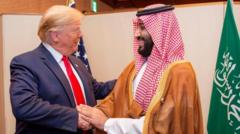
**Trump Seeks Investment Boost from Gulf States During Middle East Visit**
US President aims to secure substantial Gulf investments to bolster American economy amidst trade challenges.
US President Donald Trump is scheduled to visit Gulf States this week, with a strategic goal of securing substantial investments from the region to bolster the struggling American economy. According to economist Karen Young from the Middle East Institute, Trump aspires to showcase these investments in meetings—a symbolic act to highlight the economic impact they could have, particularly on domestic job creation and manufacturing.
Starting in Riyadh, Trump will meet Saudi Crown Prince Mohammed bin Salman on May 13 before attending a summit set for May 14, concluding his Gulf tour in the UAE. This initial trip comes following a family obligation that delayed his first overseas visit of a second-term presidency, as his first term began with a visit to Saudi Arabia—a departure from conventional presidential travel patterns that prioritize the UK, Canada, or Mexico.
The visit is critical for Trump, who is keen to return home with an announcement of new Gulf investments that align with his 'America First' policy framework. This effort is particularly focused on investment from sovereign wealth funds in the region, with a high-profile investment forum on May 13 featuring CEOs from major corporations like BlackRock and Alphabet.
Though Saudi Arabia has committed to investing $600 billion in the US over the coming years, Trump is aiming for that figure to reach $1 trillion, which could include significant military equipment purchases. Saudi commentator Ali Shihabi expects various economic agreements to be finalized during the visit that would enhance economic integration between the two nations.
Notably, the Saudi Public Investment Fund (PIF), managing assets worth $925 billion, already holds stakes in several American companies, including Uber and Lucid Motors. The UAE has also expressed plans to invest $1.4 trillion in the US over the next decade, signifying robust bilateral economic intentions.
Despite the high expectations, Young suggests that such large-scale investments might be more strategic long-term plans than immediate outcomes. Specific deals anticipated include agreements for over $100 billion in military purchases from the US, which have faced scrutiny in the past due to human rights concerns linked to Saudi actions in Yemen.
Additionally, the visit will address advancements in artificial intelligence, as Gulf states are keen on boosting involvement in US tech industries to align with their efforts to diversify their economies away from oil dependence. Following a revision of export restrictions on advanced chips, the Trump administration is poised to open up to negotiations that could benefit the UAE and enhance its AI capabilities.
Turkey's ambitious Vision 2030 program is also at play, as Saudi Arabia aims to create a more diversified economy. However, foreign direct investments in the country have seen a decline against a backdrop of lower global oil prices and challenges in attracting capital.
Ultimately, Trump's visit strategically aligns with both nations' interests—with the US looking for a narrative around significant investments and Saudi Arabia focused on reinforcing ties with its long-standing ally amid past frictions during the Biden administration. The outcome of the trip could set the stage for a renewed era of cooperation and investment between the US and Gulf states.





